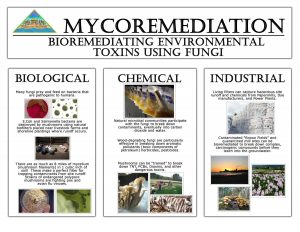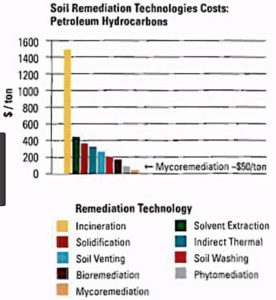As shared in my previous blog post, Mycorrhizal Fungi form symbiotic relationships with plants to transfer necessary nutrients back and forth. Plants produce sugars desired by Fungi and Fungi offer water, carbon and other nutrients to their plant friends in return.
The primary reason some Fungi are able to offer excess water and nutrients to plants is due to its mycelium, the underground vegetative growth that can cover thousands of miles. (Schmitt & Tatum, 2008) Composed of filaments thinner than human hair, mycelium act as a large absorptive web.
We’ve got that part down, right? Well, as you may have guessed, it gets increasingly more interesting and complex from there.
Mycorrhizal fungi as well as Saprobic fungi, those who digest dying or dead organic matter, have been peaking the interest of researchers looking to filter and clean, or remediate, polluted soil and waterways. Petroleum, heavy metals, pesticides, fertilizers, animal waste, polychlorinated biphenyls (PCBs) and countless other toxins have been irresponsibly managed around the globe, leaving the most vulnerable communities to face the consequences alone.
Fungi produce a variety of extracellular enzymes that degrade PCBs, polycyclic aromatic hydrocarbons (PAHs) pesticides and dyes and turn them into simpler compounds. They have also been used to pull bacteria like E.Coli from waterways and remove high concentrations of heavy metals. A 2017 Scientific analysis of various biological remediation methods proclaims that Mycoremediation is the “best option for soil cleanup.”(Ali & Mahar et al. 2017) as it the most cost effective with relatively high success rates.
There are three modes of Mycoremediation: biodegradation, biosoprtion, and bioconversion, each working differently depending on the type of fungus and environment it’s growing in. Biodegradation occurs when fungi break down compounds into simpler compounds that are less toxic and easier for the environment to use. Biosorption takes place when a fungus absorbs and removes pollutants from the environment. This works best with heavy metals, but the fruits (mushrooms) raise concerns as they can concentrate the metals they absorb. Lastly, Bioconversion involves the conversion of environmental waste into edible organic matter, providing a protein rich food source as an added benefit.
Congo Red and Eriochrome Black T (EBT) are industrial dyes that were once widely used but have been phased out due to their carcinogenic properties. A 2018 study of the crust fungus Phlebia acerina found that “under the optimum conditions the fungi was able to degrade 92.4% CR and 50% of EBT dyes” from wastewater. (Kumar, Negi, et al. 2018)This study and others like it show promise to meet the overdue and yet rapidly expanding need for remediation of damaged waterways and soils in the face of climate change.
The video below shows a mycoremediation project that took place in the Ecuadorean Amazon.
Resources:
Schmitt, C. L., & Tatum, M. L. (2008). Location of the World’s Largest Living Organism. Retrieved from https://www.fs.usda.gov/Internet/FSE_DOCUMENTS/fsbdev3_033146.pdf.
Ali, A., & Mahar, A. (2017). Mycoremediation of Potentially Toxic Trace Elements—a Biological Tool for Soil Cleanup: A Review. Retrieved from https://www-sciencedirect-com.evergreen.idm.oclc.org/science/article/pii/S1002016017603114.
Kumar, R., & Negi, S. (2018). Wastewater cleanup using Phlebia acerina fungi: An insight into mycoremediation [Abstract]. Retrieved from https://www-sciencedirect-com.evergreen.idm.oclc.org/science/article/pii/S0301479718308545.


Leave a Reply